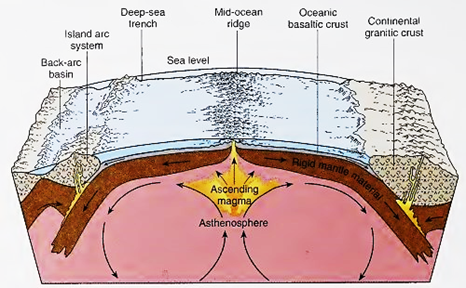The Movement of the Continents. Evidence for a New Theory
Armed with new sophisticated instruments and technology developed during World War II, Earth scientists returned to their studies of the Earth’s crust in the 1950s. Although the use of sound to examine the sea floor began in the 1920s, by the 1950s the equipment was greatly improved and much more readily available. (See chapter 3 for a discussion of echo sounders and depth recorders.) In the 1950s a worldwide effort was made to survey the sea floor, and for the first time, scientists were able to examine, in detail, the deep-ocean floor.
These surveys discovered a series of mountain ranges through the ocean basins (fig. 2.7). These ranges are 65,000 km (40,000 mi) long; they rise 2 to 3 km (1.2-1.9 mi) above the adjacent sea floor and typically are between 1000 and 3000 km (600 and 1800 mi) wide. These are the deep seas’ mid-ocean ridge and rise systems. If the slopes of these mountain ranges are steep and the width of the ranges is narrow, they are referred to as ridges (such as the Mid-Atlantic Ridge and the Mid-Indian Ridge); if the slopes are gentler and their width is broad, they are called rises (such as the East Pacific Rise).

Fig. 2.7. A physiographic chart of the world’s oceans. From World Ocean Floor, Bruce C. Heezen and Marie Tharp. © Marie Tharp 1977. Reproduced by permissmr of Marie Tharp, 1 Washington Ave., South Nyack, NY 10960
The ocean ridges typically have a central rift valley, a depression along the axis of the ridge, 50 to 3000 m (165-9850 ft) deep and 20 to 50 km (12.5-31 mi) wide. Ocean rises typically do not have a central rift valley; instead, they have an elevation (their shallowest depth) along the center. Along the axes of both ridges and rises there is a narrow zone roughly 2 km (1.2 mi) wide that is volcanically active.
Another dominant feature of the ocean floor was found to be the narrow, steep-sided ocean trenches, 6000-11,000 m (20,00036,000 ft) deep, that are most characteristic of the Pacific Ocean. Some of these trenches are located seaward of chains of volcanic islands; Japan, Indonesia, the Philippines, and the Aleutian Islands are all associated with trenches. Other deep-sea trenches follow the edges of South and Central America (fig. 2.7).
Ridges, rises, and trenches are discussed further in chapter 3. Theories current at the time of their discovery had not predicted the existence of such extensive mid-ocean features and could not explain them. However, a new theory was advanced that made the old idea of continental drift seem a possible and plausible explanation.
In the early 1960s H. H. Hess of Princeton University promoted the concept that deep within the Earth’s mantle there are currents of low-density molten material heated by the Earth’s natural radioactivity. When these upward- moving mantle currents reach the lithosphere, they move along under it, cooling as they do so until they become cool enough and dense enough to sink down toward the core again. These patterns of moving mantle material are called convection cells (fig. 2.8).

Fig. 2.8. Seafloor spreading creates new crust at mid-ocean ridges and loses old crust in deep-sea trenches. This process is shown being driven by convection cells in the asthenosphere
There are two proposed models of mantle convection. Some scientists believe that there are two sets of convection cells, one confined to the upper mantle above a depth of 700 km (435 mi) and the other in the lower mantle. Other scientists believe that convection occurs throughout the entire mantle to the core-mantle boundary; this model is called whole-mantle convection.
If the upward-moving mantle material, or magma, breaks through the lithosphere of the sea floor instead of continuing to flow underneath it, underwater volcanoes are produced and a ridge system forms along the crack in the crust. As the magma oozes out, it becomes lava, cools, hardens, and is added to the Earth’s surface as new oceanic-type basaltic crust. If new crust is being produced in this manner, there must be some mechanism to remove old crust because there is no measurable change in the size of the Earth.
The great, deep trenches of the Pacific were proposed as areas where the older, cooler, and denser oceanic lithosphere depresses and fractures the sea floor as it sinks back into the Earth’s interior, eventually to be recycled into the mantle and the convection cell system. Figure 2.8 shows this process of producing new lithosphere at the ridges and losing old lithosphere at the trenches in a system driven by the motion of convection cells.
Although some of the ascending molten material breaks through the crust and solidifies, most of the rising material is turned aside under the rigid lithosphere and moves away toward the descending sides of the convection cells, dragging pieces of the lithosphere with it. This lateral movement of the crust produces seafloor spreading (fig. 2.8).
Areas in which new crust is formed above rising magma are spreading centers; areas of descending older crustal material are subduction zones. The seafloor spreading mechanism provides the forces causing continental drift. The continents are not moving through the basalt of the sea floor; instead, the continents are being carried as passengers on the lithosphere, similar to boxes on a conveyor belt.
Hess’s model of the sea floor riding atop mantle convection cells has been modified as additional forces acting on the lithosphere have been identified. These forces are discussed in more detail in section 2.5.
Date added: 2023-11-08; views: 799;
